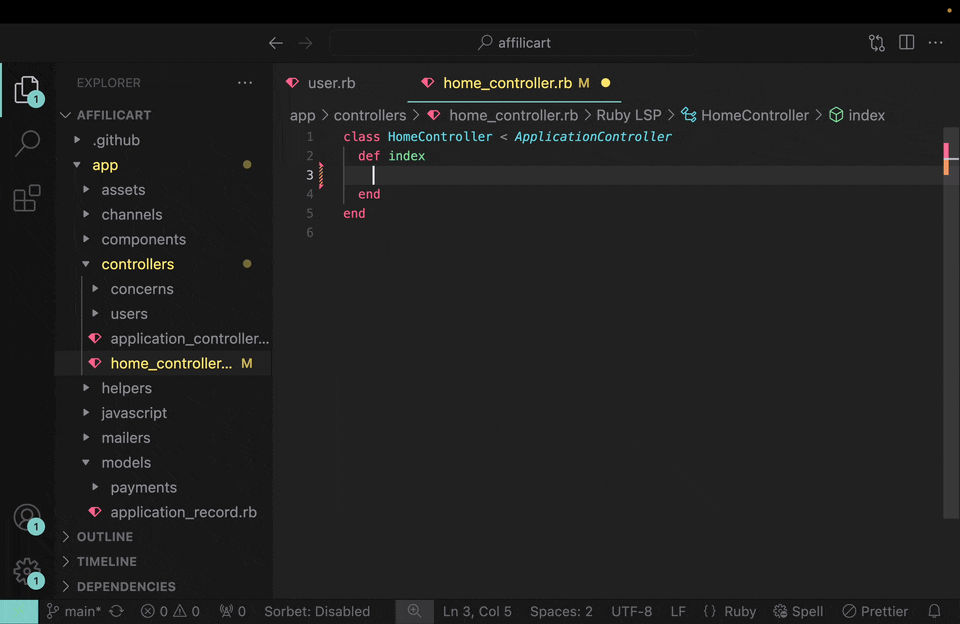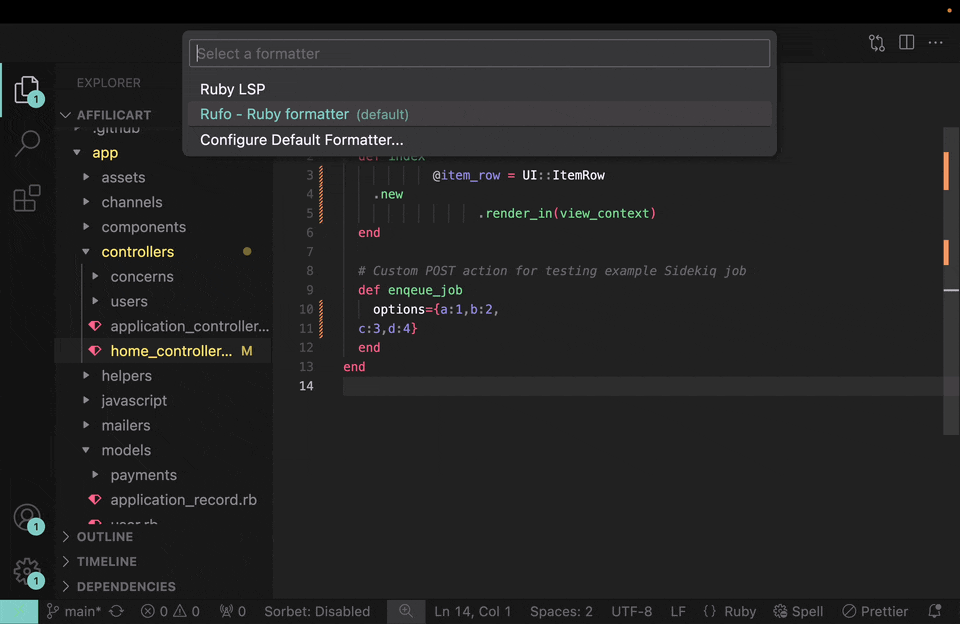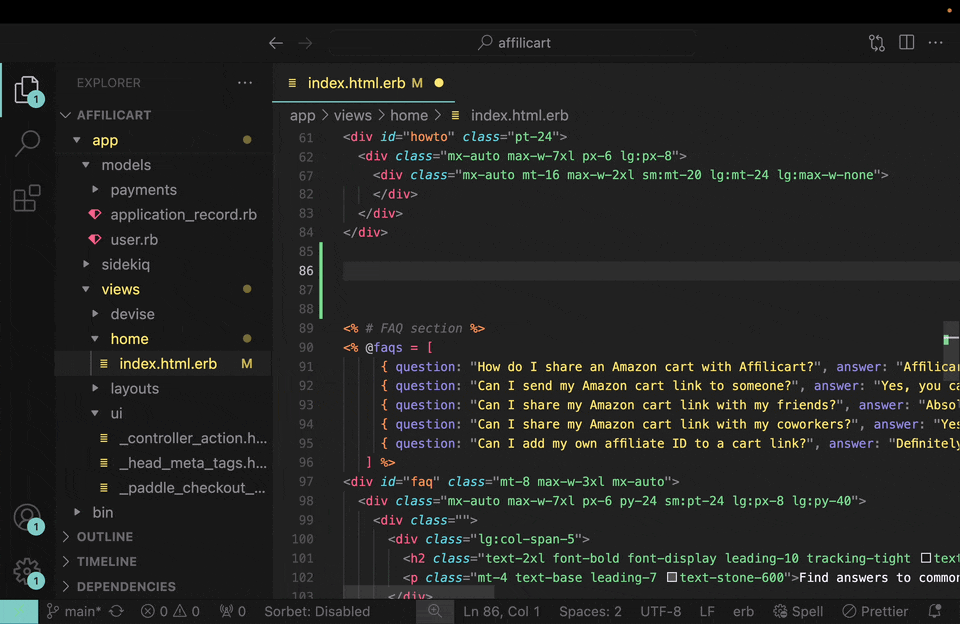- Authors

- Name
- Harrison Broadbent
- @hrrsnbbnt
Setting up VS Code for Ruby on Rails development can be tricky, so I wrote this article to help. Plus, I've turned the extensions in this article into a VS Code Extension Pack. Use it to install all the extensions from this article in 1-click, to get started quickly with VS Code + Ruby on Rails.
Table of Contents
Using VS Code as a Ruby on Rails editor shouldn't be so hard! It's tricky deciding which extensions to use, and a bunch of them are outdated or in a state of disrepair.
I'm hoping this short article will make it easier to setup VS Code for Ruby on Rails — I've collected the core extensions I use for all my Ruby on Rails editing, and even bundled them into a handy extension pack so you can install them all at once.
I've grouped the extensions in this article into four categories — language servers, other LSPs, formatters/linters, and ERB formatters and language tools.
Language Server (Ruby LSP... and Solargraph)
The language server is the bread-and-butter of an editing experience. It powers things like autocomplete, error-checking, jump-to-definition and more. In the Ruby on Rails world, we've got two Language Servers — the Shopify Ruby LSP (newer), and Solargraph (older); I run both!

The Shopify Ruby LSP is an awesome project and improving every day (literally, there are updates to the extension every few days), but after nearly 2 years of development, it still doesn't entirely replace Solargraph. I find that Solargraph is still better at autocompleting variables and method names, so I just run both (they play nicely together).
I'm hoping that one day, the Shopify Ruby LSP will overtake Solargraph in features and we'll be able to just run a single Language Server, but it won't happen for a while. Until then though, you can safely run both Language Servers together without any trouble.
Language Server Extensions:
Other LSP Integrations (Stimulus LSP and Rails LSP)
The introduction of the LSP protocol paved the way for full-fledged LSPs like the Ruby LSP from above, but it's also made it easy for smaller, bespoke LSPs to integrate with VS Code. There are currently two key LSPs worth checking out — Stimulus LSP and Rails LSP. Both are great!
The Stimulus LSP from Marco Roth gives you editor suggestions for Stimulus controllers, and the Rails LSP from Shopify lets you hover over models in your app to view their schema.
If you're using the Rails LSP, make sure to follow the installation instructions by adding it to your Gemfile —
group :development do
gem "ruby-lsp-rails"
end
Note: the Rails LSP sits on top of the Ruby LSP extension. You don't need to install an extra extension, just the gem.
The Stimulus LSP gets updated pretty frequently and is shaping up to be a really handy tool for building Stimulus controllers; The Rails LSP is pretty barebones right now, but I'm hoping that once Shopify has the Ruby LSP in a good place, they'll shift their focus to enhancing the Rails LSP.
Other LSP Extensions:
Rails LSP (just add the gem to your
Gemfile)
Ruby Linter & Formatter (Rubocop, Standard and Rufo)
Linters and formatters tend to go hand-in-hand, despite being slightly different — linters correct code style (like how you structure conditionals), whereas formatters correct code formatting (like whether to insert a space inside hashes).
Both are typically must-haves for any non-trivial project — they keep your code consistent between files and projects, and between teammates too.
The linter/formatter you pick just comes down to preference. Do you want to:
- use heavyweight Rubocop and tweak it until you're happy,
- choose Standard as a prescriptive linter + formatter,
- forgo linting altogether and use Rufo for formatting?
I use Rufo in all my side-projects, and Standard at work — I like how prescriptive they are (compared to Rubocop), and I find that for side-projects I'm fine giving up linting for my preferred formatter, Rufo.

Note: make sure you've got the
rubocop,standardorrufogems available in yourPATH(depending on which one you choose). You'll probably need to run one of:
bundle add rubocopbundle add standardbundle add rufo
Ruby Linter & Formatter extensions:
Debugger (VS Code rdbg Ruby debugger)
There's just one extension you need to care about for interactive debugging in VS Code — it's the VSCode rdbg Ruby Debugger extension.
The extension is great (and powerful)! It can connect directly to debugger instances in your code, attach to multiple debuggers at once (ie: sidekiq: and web: processes in Procfile.dev), automatically connect a debugger whenever your app raises an Exception, and more!
Some setup is required to use this extension. I decided it was a bit too much for this article, so I've broken it out into a separate article — Using Rails debugger/rdbg with VS Code.
The quick overview though is that you need to export the RUBY_DEBUG_OPEN=true environment variable, install the extension, and then create a launch.json file in the VS Code "Run and Debug" menu. I initially put off doing this, but it's a really handy extension and takes 5 minutes to set up, so I reckon it's worth giving it a shot!
Note: This section was added on March 13th, 2024 (after this article was originally published).
ERB Formatter / Language Tool (Simple Ruby ERB, ERB Formatter/Beautify)
Finally, you'll need a separate set of extensions to handle Rails view templates. ERB is the most popular, and it's what I use, so I've included ERB-related extensions (you'll need to find your own extensions for HAML or Slim).
I use two ERB extensions for VS Code — the first is Simple Ruby ERB. It's terribly maintained (last updated: 7 years ago), and I only really use it for the ctrl + shift + , shortcut to insert and cycle through ERB tags (<%%> --> <%=%> --> <%#%>). It does also have some basic helpers for if/else blocks, link_to etc. which I occasionally use (full list here).
The other ERB extension I use is ERB Formatter/Beautify; it's a formatter for .erb template files (duh!). It works pretty well, although I prefer how Rufo formats Ruby within ERB files so I usually run both across a file.

There are a bunch more ERB extensions that you can try out (for things like code snippet suggestions), but I'm pretty happy with these two and find them to be enough.
Ruby Linter & Formatter extensions:
Conclusion
That's it! I try to keep my set of VS Code extensions pretty lightweight, but I'm sure there are a bunch more great ones out there.
I hope my Ruby on Rails VS Code extension pack is handy to you! I think it's a great way to get VS Code installed with a solid baseline set of extensions to cover all your bases.